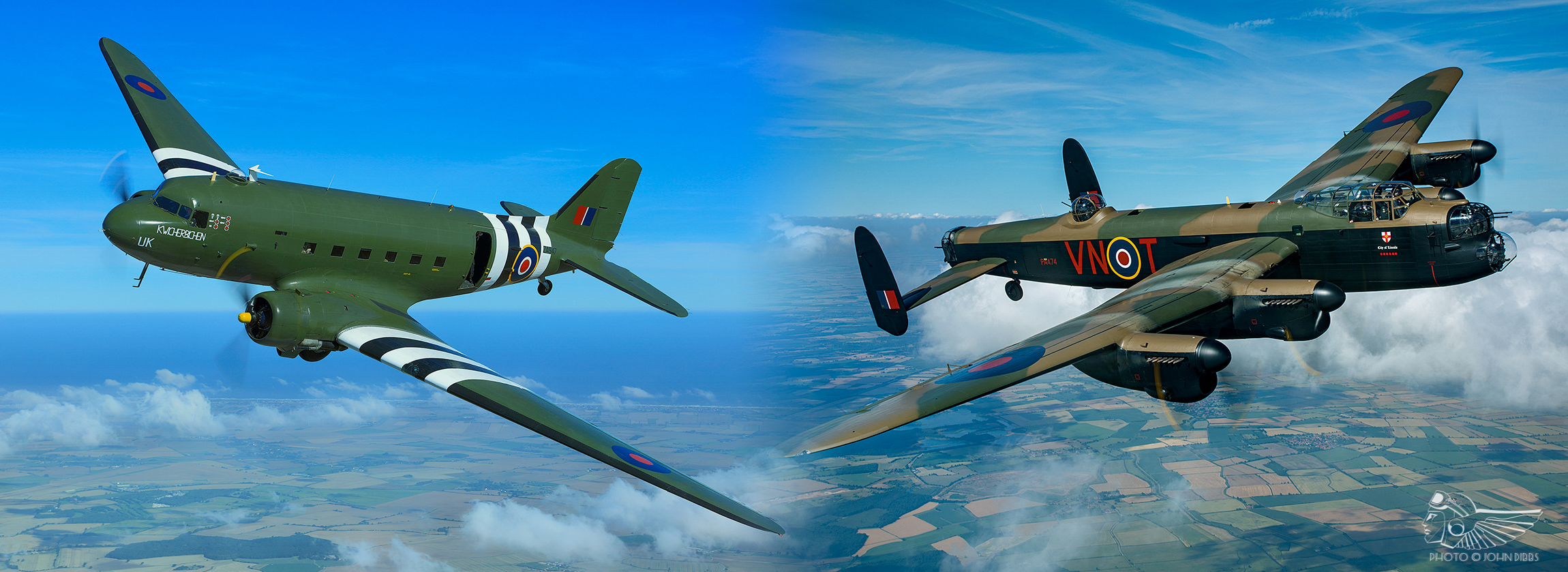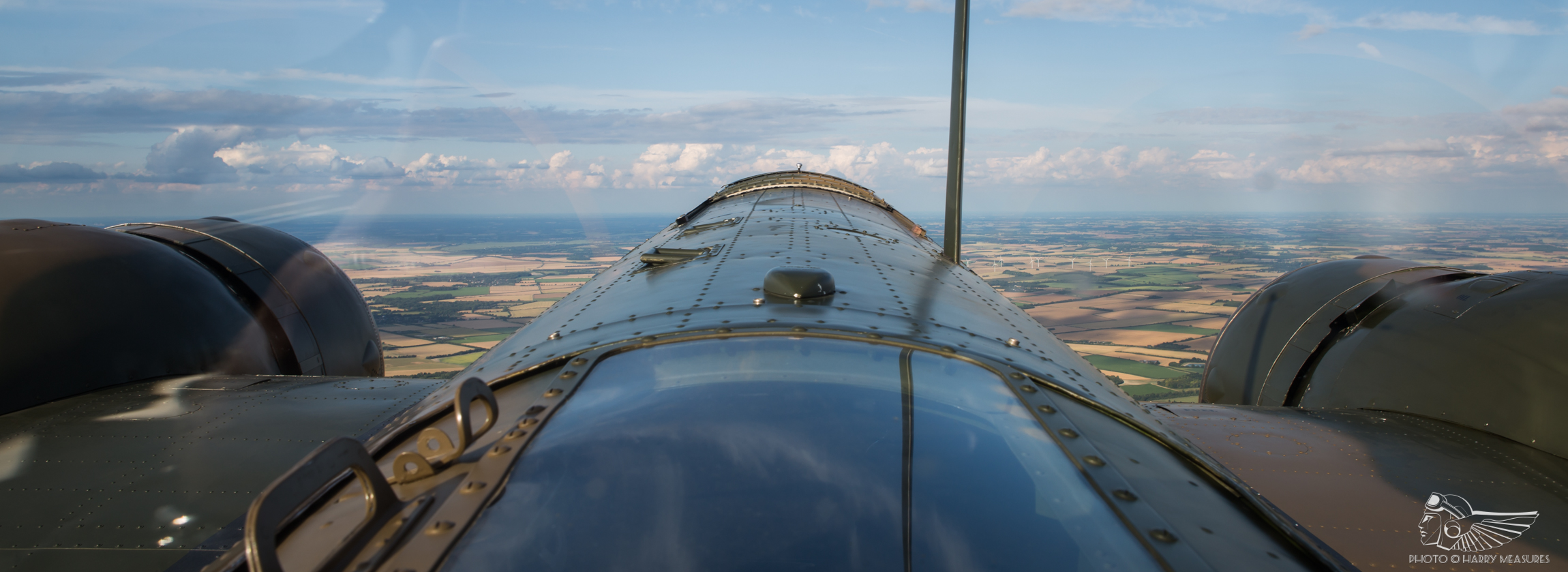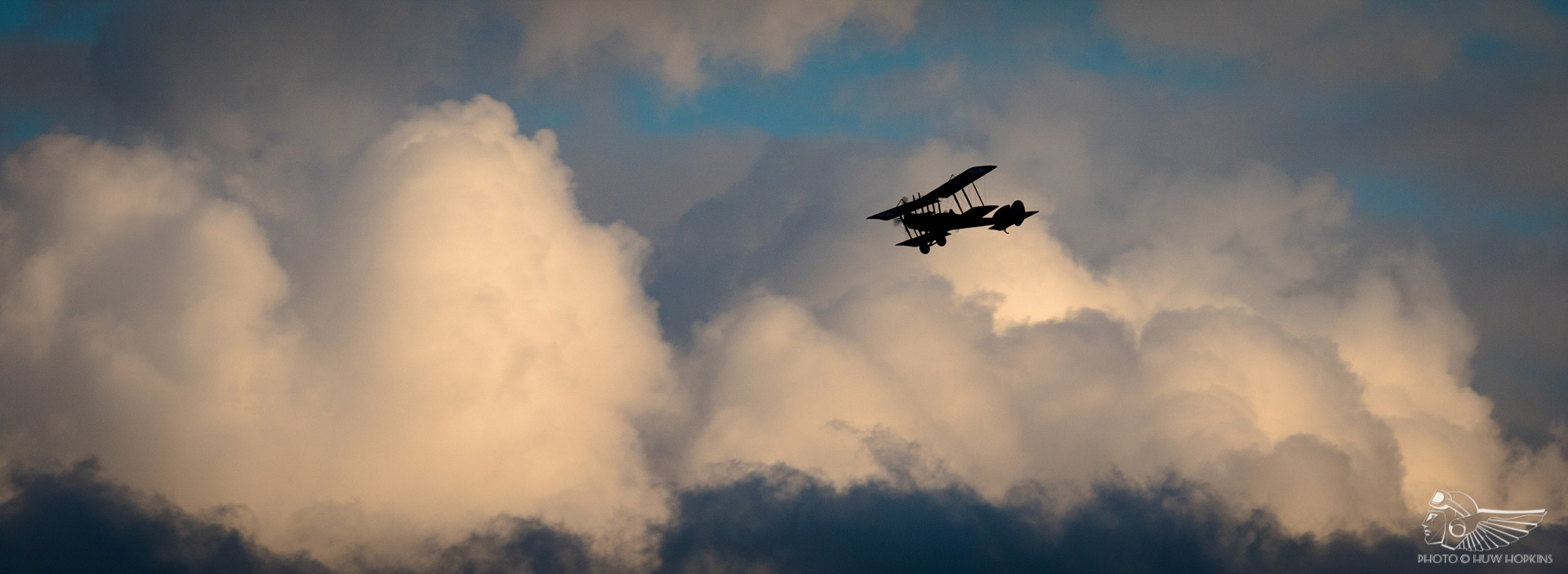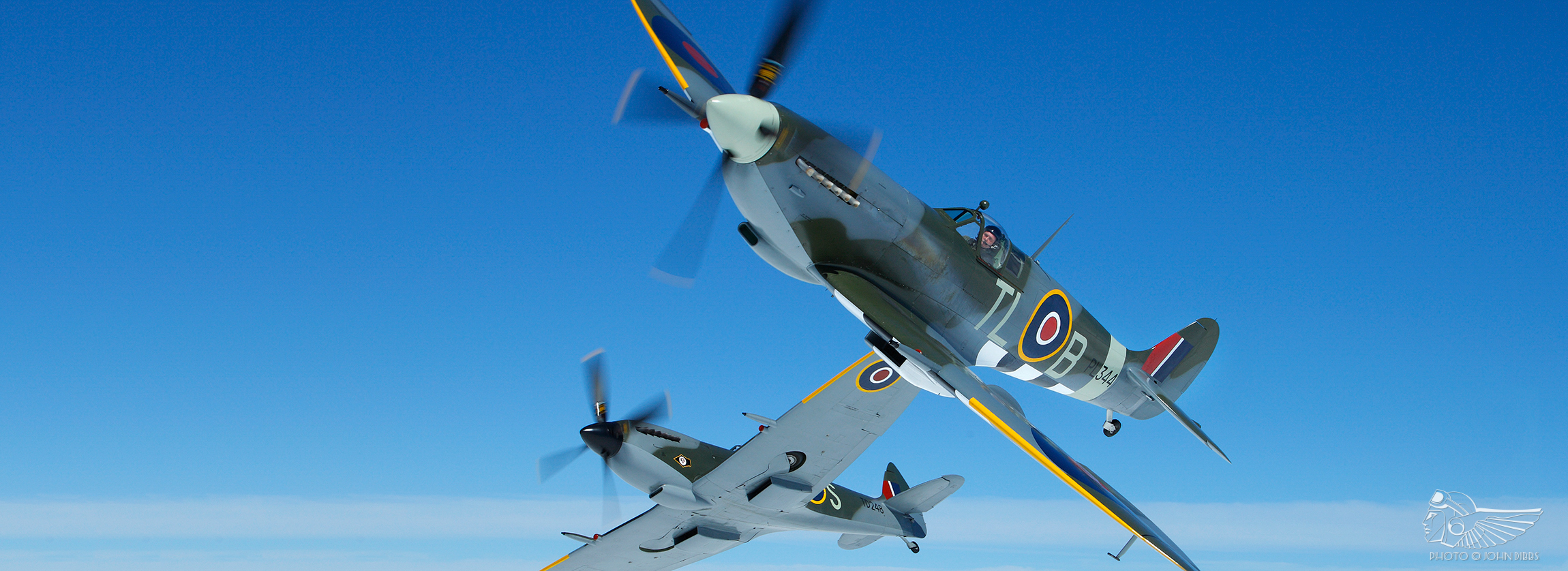Since its inauguration as the RAF Historic Aircraft Flight in 1957, the Battle of Britain Memorial Flight (BBMF) has participated at thousands of events, from village fêtes to major international airshows, accumulating vast numbers of flying hours. That feat is even more impressive for the fact that its fleet – now comprising two Hurricanes, six Spitfires, two Chipmunks, Dakota and Lancaster – is maintained and flown by serving RAF personnel who fulfil their obligations alongside frontline operations.
As Bomber Leader with oversight of the BBMF’s multi-engine crews, Flt Lt Neil Farrell plays a fundamental part in the recruitment and training of the new ‘bomber boys’ who will go on to fly the Douglas C-47A Dakota and, in time, the flagship of the Flight – Avro Lancaster B.1 PA474. Taking frontline RAF pilots whose experience is broadly on modern and more automated types and training them to fly a four-engine V12 taildragger bears a weight of responsibility Farrell is acutely aware of.
Whilst the Officer Commanding BBMF oversees the running of the Flight in its entirety, heavy multi-engine aircraft operations are overseen by the Bomber Leader. Having joined the Flight in 2014, Neil was selected for this position in 2019 owing to his background in instructing, succeeding Tim Dunlop. Aviation was ever-present in Neil’s upbringing; his father had been in the service as an engineer and subsequently moved on to the airlines, so it stood to reason that his son would inherit an interest in aviation and follow suit. He joined the RAF in 1996 and was initially selected as a rotary pilot, training on the Bulldog, Squirrel and Griffin at RAF Shawbury from 1998 to 1999. He came top of the course, and a subsequent operational posting onto the Wessex took him to Northern Ireland and Cyprus. Thereafter he became a Qualified Flying Instructor (QFI) on the Tutor, where a passion for instructing came to the fore. Enrolment onto heavy aircraft followed, via RAF Cranwell for multi-engine training on the King Air, after which Neil took an instructor posting with No. 8 Squadron on the E-3 Sentry in 2008 – a role he is still in, having since moved to No. 54 Sqn at RAF Waddington.
“My job as Bomber Leader is to be the umbrella over everything, to make sure it all runs smoothly, and the crew get what they need in terms of training and mentoring”, says Neil. “It’s very much a closed process with Seb Davey, who’s the other Lancaster captain and instructor. He’s been on the team a year longer than me, but he wasn’t an instructor when he joined. I’m supported very much by Seb and I work very closely with him and value his opinion.”
As members’ tenure on the Flight is typically dictated by the demands of their primary service occupation, the renewal of personnel is pivotal to the BBMF’s ability to uphold its many commitments. Though there are currently five pilots serving the needs of the bomber fleet, people’s circumstances can and will change.
“If we have anyone who is thinking of leaving, a signal will go out,” adds Neil, “and that will invite applicants who we will then sift through and assess individually”. The process then sees Neil and Seb sitting down with OC BBMF Mark Discombe to review each applicant’s Form 5000 – a comprehensive file that includes every report written about them as a pilot during their time in the RAF. “We’re looking for any real strengths and weaknesses,” Neil says, “and as they’re all high calibre, they will inevitably all meet the criteria. You’ve got to whittle it down to a handful and it’s that selection who will get the request to come for an interview. We’re quite a small air force these days and you know by and large who the applicants are. It isn’t difficult to see a name and think, ‘You know what, they’d be great!’”
Candidate selection is followed by the interview process, typically beginning in January or February and leading into the Flight’s pre-season build-up in March. “When I did it we all met on the Flight and we went out for a team curry the night before and a couple of beers. People say you’re being assessed the whole time – you’re not! You’re literally out just to get a beer and a curry to get to know everyone, and then in the morning the interviews start and on the day of the interview you’re told the result. There’s no messing around – it’s a simple, ‘Well done, you’re on the team!’”
Mandatory ground training in early Spring brings new and established crews together irrespective of their time with the Flight. “That will involve going into the hangar, getting into the aircraft, learning about the emergency escape exits, hatches, the dinghies on board, the fire extinguishers – getting to know the safety equipment. Then it’s into the classroom.” In this ground school, the more experienced members of the team will be allocated a subject to teach to their peers via a series of lectures, be it technical insights into systems or in-depth procedural overviews of standard flight ops.
Then, it’s on to the Dakota – the first port of call for a new pilot on the bomber fleet. “They won’t go anywhere near the Lancaster until they are fully qualified on the Dakota”, Neil nods. “It’s actually a very steep curve. People always ask, ‘Did you do some time in a Chipmunk or the Harvard first?’ Nope! It is straight into the Dakota to get on with it. You’re picking people here that have got a lot of experience on aeroplanes, period, so they tend to pick up the theory of the aeroplane and a new set of drills quite quickly – the challenge is getting used to the quirks of the aeroplane. The big difference for all of us is that we had never had any taildragger experience, and that is a different animal!”
Douglas C-47A Dakota ZA947 was taken on charge by the BBMF in March 1993, having been put up for disposal at the end of its tenure with the Defence Research Agency (DRA) the previous year. Originally intended to replace the Flight’s de Havilland Devon support aircraft and act as a trainer for the Avro Lancaster, it is an important aircraft in its own right and an active part of the Flight’s public commitments throughout the season.
New recruits face three flights under the instruction syllabus. “We’ll have a little bit of familiarisation time with all the controls, but basically it’s three trips with the instructor to get acclimatised to the new aeroplane”, explains Neil. “The first one is to explore the effects of control inputs. First off myself or Seb will sit them in the cockpit and go through the start-up procedures. The hardest thing about the Dakota is getting it started; it’s all hands and switches everywhere – it’s really a two-person job.” With just three instructor trips in the syllabus, the student pilot is afforded plenty of hands-on time to familiarise themselves with the aircraft. “There’s only so much someone can learn through observation. They do the first start-up, as demonstrated by us. They’ll taxy it for the first time, they’ll do the first take-off, and once airborne they will get used to speeding the aircraft up and slowing it down and how to manage the power settings to achieve that. A prime example of that is the cruise; it’s a four-stage process to get more power out of the engines once it’s in cruise, so the pilot will go through all the normal procedures of flying it and handling it to learn both control inputs and engine management.” Towards the end of the first sortie, attention turns to getting the aircraft back on the ground and stalling will be practiced at height before the crew returns to Coningsby for practical circuit training with a series of touch-and-goes.
“The next trip is asymmetric flight”, Neil continues. This sees the crew climbing to height to go through single engine failure drills. “They’ll actually shut the engine down in flight and feather it for confidence reasons to show that the aircraft will fly well on one engine. Subliminally there’s a little bit of extra teaching going on there about what a nightmare of a thing it is with throttles and levers all over the place, so when it happens for real, this is the nightmare you’ve got to live with! There is considerable husbandry involved in restarting the engine in-flight, and the engine’s cooled down – you can’t return to high power immediately and it’s important to impress that on students.
As with the first sortie, the Dakota will be brought back to Coningsby for circuit training, this time followed by practice engine failures in the climb-out after take-off. “By this point you’ve done two start-ups and shut-downs, a load of stalling, a load of circuit work and some emergency handling – and that’s about two and a half hours in the air so far,” adds Neil.
The third trip consists of 30 minutes of touch-and-goes and is the classic ‘dual-to-solo’ trip. “We’ll do maybe three or four normal circuits, then we’ll spring an asymmetric drill on them, or an overshoot and then a landing, and providing all that is carried out safely, the instructor will get out and the trainee will go off for half an hour and fly a load of circuits. With about three hours on the Dakota, having never flown a taildragger, having never flown a warbird, they’re suddenly set off on their own. It’s quite a steep curve!”
Though these training sorties are ideally flown over a few weeks in March, the timescale remains somewhat flexible as they are naturally subject to crew availability, weather and serviceability. Another added benefit of training a new pilot is the ability to conduct annual re-currency flights for existing navigators and flight engineers concurrently.
Subsequent sorties are all about building a new pilot’s experience on type. “We’ll cut him loose on his own again to go and build a bit of confidence. The navigators will want to go out and practice an hour of point-to-point navigation and hitting a time on target, so there’s a trip in the syllabus where we send the pilot off on their own with an experienced navigator and loadmaster to go and do a low-level navigation exercise for an hour, come back and do a few more circuits.”
Standardised RAF training ensures that new crews from different backgrounds gel seamlessly, as Neil explains. “We’ve all learnt crew resource management at a very early stage in the RAF and know how to get on with a crew and get the best out of them. If you know the aircraft drills from the flight reference cards, it quite clearly dictates who does what, who’s responsible for what, who has a challenge-and-response function in the aircraft – they know when it’s their turn to speak and when it’s their turn to listen. You kind of do your own thing as per the aircraft’s manual and you know what your responsibilities are; it just slots into place nicely. Although your Hercules pilot has never flown with a Tornado navigator and you’re about to crew them up in a Dakota, you know it’s going to work.
“After that, it’s on to the display work up. It is, again, a very steep curve!” notes Neil. More ground schooling, this time covering the air display sequence and the rules and regulations of airshows, precedes another sortie with either Neil or Seb. “We will teach them the five-minute display singleton bomber profile [in the Dakota] by demonstrating it with them on board. Then they’ll practice – a couple at 500ft base height, then we’ll go down to 100ft.” The instructor will then observe the student’s practice from the control tower, with a debrief following each practice display to identify areas for improvement.
Ideally that should bleed into their Public Display Authorisation (PDA) sign-off in late April, with a final practice scheduled in the days prior to assessment. “PDA itself is quite a tricky day, as there’ll be the fighter pilots doing their bit, the Dakota crew doing theirs and the Lancaster crew doing theirs – and this is one of the Boss’ biggest headaches.
“There’ll be a PDA rehearsal and then there’ll be a PDA day. It’ll be a very well-choreographed event – it’s actually quite a data practice itself,” continues Neil. “For the new crew, it can be quite daunting; they don’t want to mess it up, so we normalise the day as much as possible to mitigate that pressure. We’ll have practiced the day before, so there’s nothing new for them on PDA day itself.” The day is a good eye-opener into the requirements of the airshow environment, with the Dakota display slotted between the fighter and Lancaster displays, helping to ready the pilots for the kind of strict timings they will encounter during their public appearances. Dakota crews invariably carry out more flypasts than displays each year, gradually acclimatising to the display environment and building their knowledge of various airports and display venues.
The first year for a new bomber fleet team member is quite a journey; having captained the Dakota they will typically move onto the Lancaster as a co-pilot after the Flight’s mid-season break at the end of July. The BBMF requires its bomber pilots to have flown five hours as captain in the Dakota, amassing 20 tailwheel landings, as a bare minimum to begin the conversion to the Lancaster. Inevitably, Neil says, they will have a lot more than that by the time they step into the Lancaster’s captain’s seat. “The pilots will have undergone the Lancaster ground school at the start of the year and they’ll have their aircrew manuals, meaning there’s an element of self-study involved. Good instructional technique will be to refresh the bullet points from the earlier ground school, the headlines that you need them to know. The numbers and limits of flying a circuit, how to fly an asymmetric circuit, that kind of thing. You’ll refresh all of that before you do any flying in the aircraft.”
Flying the Lancaster is an awe-inspiring experience for many converts, and part of the training syllabus addresses this by giving crew members the opportunity to enjoy a flight before their first instructional sortie. “Once the team has got its PDA and they’re doing their own thing in the Dakota, at some point you will find a straightforward trip and sit them in the upper turret or something on the Lancaster, and you’ll get that wow factor out of the way!” says Neil, explaining that it doubles as a subtle knowledge transfer exercise. “They’ll get a chance to see and hear what a typical flight is like; to listen to the sounds, the procedures, who’s speaking when, who’s responding and who’s responsible for what. When they finally come to that first Lancaster ‘lesson’, they’ve got a bit more of an idea of what is to come.”
Neil still remembers his first Lancaster flight fondly. “We did a flypast down at High Wycombe on a Thursday evening in the middle of summer [2014] – it was just wonderful! I was in the upper turret, which gave me some perspective. It’s a big bubble stuck out in the airflow and you feel very exposed up there. My absolute respect goes to those guys who flew in that position during the war.”
For the student, the progression to Lancaster co-pilot isn’t quite as involved as the Dakota captain conversion. “As a co-pilot you will not land the Lancaster. The right-hand seat is not a permanent fixture in the aircraft; the flight engineer used to manage the throttles for take-off then put it away and go and monitor his panel for the rest of the flight.” Though a temporary fixture, the co-pilot’s seat is equipped with full flying controls – a permanent second yoke and fold-out rudder pedals – enabling the co-pilot to fly the Lancaster from the right seat, though the captain takes charge for displays and landing.
“As the co-pilot, you’re very much there to provide a service,” adds Neil, “supporting the captain and helping him with throttle, rpm and other services to be moved during the flight, like gear and flaps.” As such, the conversion is brief, initially consisting of a handful of trips focussing on the engine start-up and warm-up procedures. “You’ll then do some upper air work, some handling, and a little bit of low-level flying,” Neil continues, “then come back to the circuit. The captain will do some touch and goes, with the co-pilot doing all the throttles and flap level movements. There are a couple of short trips like that and all of a sudden you’re a co-pilot on the Lancaster!”
From that point, Neil will put them into the fray for the remainder of the year’s flight allocation with a mix of flights as Dakota captain and Lancaster co-pilot. “I’ll just try and spread the love out as much as I can so that everyone gets a fair hand!” jokes Neil, adding that “the ‘gotcha’ as a Lancaster co-pilot is that you don’t land the aeroplane. If I just allocate them flights in the Lancaster at that point, they wouldn’t be performing any landings, and they have to have five tailwheel landings in a 30-day period. Subsequently, they’ve got to have some time in the Dakota to keep themselves current on tailwheel landings.” Pilots will enjoy several seasons like this, building experience incrementally.
A baseline of ten Dakota hours and 30 tailwheel landings is a prerequisite for promotion to Lancaster captain, though the reality is that pilots will have accumulated considerably more experience before stepping into the left seat. “You really do want to make sure they’ve had lots of exposure to displays as a co-pilot. I remember when I was a co-pilot on the Lancaster, it suffered an engine fire and was out of action. That slowed me down getting my command. But you know what, I wasn’t bothered. You’re itching to do it, but you’re also itching not to cock it up. When everyone thought I was ready, and when I thought I was ready, I was happy to do it. It’s such a majesty, it’s not something you’ll want to mess up.”
Conversion to Lancaster captain is a relatively benign process owing to the assimilation of knowledge whilst flying the Dakota and co-piloting the Lancaster. “There’s no more ground school to do because as a co-pilot you know the limits of the aeroplane by now”, Neil says. “You know what a three-ship display looks like, you know what an asymmetric circuit looks like, you are just literally swapping seats and you’re doing all of the hands on.
“The Dakota is a very good training vehicle to get you in the Lancaster,” continues Farrell, adding that the twin is a fundamental step in the progression to Lancaster pilot. The standardisation of operating procedures also helps. “The Dakota’s quite sturdy, forgiving and solid – as is the Lanc’ in many ways – but the latter has just got that edge that can bite you. It’s a handful to taxy and it’s a real handful to land. A lot of the numbers we use in the Dakota are the same in the Lancaster – rotate, for example, is 90kts. We try and mimic as many numbers as we can to make that transition easier. The display profile is the same for both of them too, but in many ways the Dakota is a bit more complicated than the Lancaster in terms of engine management, would you believe. The Lancaster also has a little bit more automation with the fuel and mixture.
“I think the Lancaster is an exceptionally simple aeroplane for what it is – it’s lovely. In many ways it is the best of British engineering because it is so simple and easy to use. It is beautiful to fly – when it’s in the air, it’s a dream; you can feel it’s a bit heavier but you can feel it’s still well balanced and very responsive. It’s just that interface between the air and the ground where it is a different animal. You don’t want to rush things in that respect.
“As a co-pilot they won’t have landed the aircraft from the right-hand seat, but the instructor will demonstrate one landing from the right-hand seat in that first captain’s conversion sortie. The circuit is similar to that of the Dakota, but the Lancaster is a bit more gangly at low speed, which they need to get used to. After that, you’re on your own, so to speak, and it’s all done by you in the left-hand seat.”
Aside from Dakota captain experience and co-piloting the Lancaster, ground handling is an essential part of understanding how to control the aircraft. “Taxying is hard work in the Lancaster, I don’t mind telling you that!” he says of the 16-ton bomber. “It’s very different to the Dakota in that respect, which has got toe brakes that allow you to turn tight corners; you can dab the inner toe, add a boot load of rudder, and around you go. The Lancaster has got a pneumatic braking system and it’s done by squeezing a lever on the control column. There’s a bit of lag in that because obviously air is compressible. You put a bit of rudder in, squeeze the brake lever and that will bite the right brake, but it will take a while to bite and before you know it there’s too much, so you go full deflection the other way and you’re zig-zagging all the way down the taxiway!
“Also, whilst you can lock the tailwheel to keep straight in the Dakota, there isn’t such a function on the Lancaster. It takes a while to get used to it and get a feel for it. If you see the Lancaster zig-zagging, you know what’s going on – he’s not got the feel for it yet! It takes a bit of courage but if you can taxy faster, it’s easier, because you get airflow over the rudder and the rudder is a bigger help than the brakes.
“It doesn’t just stop once you get PDA,” Neil notes, “and I think it’s quite important to highlight that.” As Bomber Leader, he oversees the instruction and running of the bomber fleet, but is keen to stress that it is very much a team effort for the instructors. “For me and Seb – it’s not all about me, we work very closely together – it’s up to us to keep the crew ticking over and ensure that they’ve got everything they need to continue.” The bomber pilots must log at least five tailwheel landings in 31 days, though myriad factors including availability, weather and serviceability are likely to render this impractical. “It doesn’t take much for that to go out of the window. All of a sudden, the pilots are coming up to the end of the rolling 31 days and they haven’t got enough landings to keep going. That’s where we need to keep an eye on it and be available to go down to Coningsby and fly with them, as when you fly with an instructor, it resets that landing requirement.
“Also, and this is good practice for any aeroplane – you’ve got to keep checking people. After the mid-season break, Seb and I will try and fly with all of the guys and give them a little bit of a workout, just to make sure that no bad habits are coming in and that they are operating the aeroplanes in accordance with the instructor guide and the aircrew manual and the way we taught them. BBMF is seasonal, and if we flew with them in the spring alone, it’d be 12 months before we fly with them again – that’s bad practice, and we avoid that. We’ll write a little report on them following the check flights and say, ‘Well done mate, nicely done and away you go’. There’s a little bit of positive assurance there too.”
That presents quite the balancing act for team members. “Many people refer to it as another primary duty. It can be all-consuming in May and June straight after PDA. Busy, busy weekends but you do your best to spread it out. You have to take a mandatory rest. If you’re flying all week, or at least working all week on your primary aeroplane, and then you’re working BBMF all weekend, you’ll have some time off that following week. That can be a juggling act, because your frontline squadron, your main job if you like, needs to be able to rely on you too.”
The Flight’s seasonal nature offers a different challenge earlier in the year. “There’s an element of risk for you to have not flown an aeroplane since the end of the season – let’s call that end of September – and for it to come out of the shed mid-February or early-March and you to strap in cold and go and give it a shakedown”, says Farrell. “Unfortunately, there is no other alternative. There is no other large taildragger that we can keep current on, the mitigation is that you’ve picked some of the most experienced guys in the service who are available. Who else is going to do it?”
This is where the further development of the Flight’s pilots comes into play. Once a pilot is signed off as a Lancaster captain, that isn’t necessarily the end of the progression. “The next thing to come is that we may make you an air test captain, so when the aircraft comes out of the shed at the start of the year, you’ve got to give it a shakedown – that’s a separate training module and qualification that Seb and I have. There’s also an air-to-air photography qualification. If you’re an instructor in the air force we may make you an instructor on it; there’s further training to get that qualification, and then there is the task of considering who will progress to become the next Bomber Leader in time.
“I remember when I joined, Tim said, ‘Look mate, you are the next obvious candidate to be Bomber Leader’, and that was purely a function of having a good background in instructing,” Neil recalls, “so you get earmarked as going to be an instructor and possible bomber leader in three or four years.” At the time, Tim and Neil were the only instructors on the Flight; with an A2 instructor’s rating on the Tutor and Sentry, Farrell was the logical choice to succeed Tim as Bomber Leader.
“It’s very much like becoming an instructor on any other aeroplane; you get given the instructional package and you are taught how to teach on the aeroplane. This includes how to set the aircraft up for an instructor and the order in which that is done. Obviously, you’ve been taught this when you did the conversion, but you’re not worried about the order and the set-ups at that time, you’re worried about learning the aeroplane. It’s called a ‘give and a give back’. You’ll receive a lesson from Tim, and you’ll then reverse the positions and play the role of instructor in the right-hand seat with him as the pseudo student, then he’ll debrief you and you’ll move onto the next lesson.”
Once the pair have moved through the syllabus, Exam Wing at RAF Cranwell will be contacted to visit Coningsby and observe the trainee instructor running through the ground school package, pre-flight brief and in-flight lessons. All being well, Exam Wing will debrief and sign off the new instructor.
“As Bomber Leader, I am not omnipotent,” says Neil, “and I fly with the Exam Wing annually to make sure we’re practicing Central Flying School instructional techniques. It keeps us sharp! I’ve got to do it for every aeroplane I’m an instructor on, so Exam Wing will watch me on the Sentry, the Dakota and Lancaster. They’ll do the same for every instructor.” Annual observations aside, in-house assessments are also commonplace. “You know what, Seb and I check each other, too. When we can, I’ll factor in Seb flying with me and he’ll write a report. It’s only right.
“I’ve got to be checked as an instructor and I’ve got to be checked as a line captain, just as I check people on the Sentry as well as the line captains – so it’s the same practice in the wider RAF as we have on the BBMF.”
A weather eye must also be kept on the future, and the succession of instructors that will uphold the system. “I’m soon to take up a posting in Scotland so I will have to leave the BBMF after this season. Seb will take over as Bomber Leader and we’re already looking at Ernie [Paul Wise] to start graduating him as a Lancaster captain, and then we will start making him an instructor. It’s very important that we start training up the guys to replace Seb and me. Got to think ahead!”
Looking to the future and beyond Neil’s time on the Flight, the gulf between the modernisation of the RAF’s frontline fleet and the BBMF’s heavies widens; does that pose an insurmountable challenge for new crews and the instructors training them? “It’s a very good question! I think there are still a few of us old hands around, so for the next five to ten years I think it should be okay and we’ll still be able to recruit pilots who have experience on ‘manual’ types of aircraft. We’re quite lucky at the minute, because guys like Seb and I have gone through flying training where it’s hands-on. You were never allowed to rely on the autopilot during flight training, other than for short periods of time. I started off on the Wessex, did six years teaching on the Tutor, then came to the Sentry, which has a very, very crude autopilot. So by and large that aeroplane is hands-on. Seb, Chris [Fairley] and Ernie [Paul Wise] have all come from the Hercules, so low-level environment and hands-on, and Mat [Moore] is a test pilot, which speaks for itself. He’s ex-Nimrods, so he’d been flying them low-level over the sea for most of that time.
“If you look at the Atlas, which is Seb’s primary role, it’s a very automated aircraft,” he continues. “I’ve had a go in that sim – that thing does everything for you! I think generationally we’re okay at the minute, but in the next decade we are going to witness that change in background, which will be quite interesting. If you’ve got someone who is next generation who’s flown the Phenom and then they’ve gone to something like the Voyager or the Atlas, or something very automated, the only way you’re going to mitigate it is to put another training aircraft in before the Dakota, or simply increase the flying hours in the Dakota syllabus. That’s probably the only way you’re going to do it, but time will tell. If there’s any doubt, we’re just going to have to throw more hands-on flying hours at the problem.”
Neil’s reflections have an added poignancy with his nearing departure from the Flight. Regardless of the challenges BBMF’s intake may face in years to come, Neil and his successors will continue to play a fundamental role in its longevity, passing the baton and ensuring that this new generation of ‘bomber boys’ can carry the torch into the future.






















